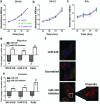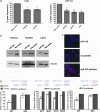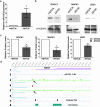MiRNA-335 suppresses neuroblastoma cell invasiveness by direct targeting of multiple genes from the non-canonical TGF-β signalling pathway
- PMID: 22382496
- PMCID: PMC3334516
- DOI: 10.1093/carcin/bgs114
MiRNA-335 suppresses neuroblastoma cell invasiveness by direct targeting of multiple genes from the non-canonical TGF-β signalling pathway
Abstract
Transforming growth factor-β (TGF-β) signaling regulates many diverse cellular activities through both canonical (SMAD-dependent) and non-canonical branches, which includes the mitogen-activated protein kinase (MAPK), Rho-like guanosine triphosphatase and phosphatidylinositol-3-kinase/AKT pathways. Here, we demonstrate that miR-335 directly targets and downregulates genes in the TGF-β non-canonical pathways, including the Rho-associated coiled-coil containing protein (ROCK1) and MAPK1, resulting in reduced phosphorylation of downstream pathway members. Specifically, inhibition of ROCK1 and MAPK1 reduces phosphorylation levels of the motor protein myosin light chain (MLC) leading to a significant inhibition of the invasive and migratory potential of neuroblastoma cells. Additionally, miR-335 targets the leucine-rich alpha-2-glycoprotein 1 (LRG1) messenger RNA, which similarly results in a significant reduction in the phosphorylation status of MLC and a decrease in neuroblastoma cell migration and invasion. Thus, we link LRG1 to the migratory machinery of the cell, altering its activity presumably by exerting its effect within the non-canonical TGF-β pathway. Moreover, we demonstrate that the MYCN transcription factor, whose coding sequence is highly amplified in a particularly clinically aggressive neuroblastoma tumor subtype, directly binds to a region immediately upstream of the miR-335 transcriptional start site, resulting in transcriptional repression. We conclude that MYCN contributes to neuroblastoma cell migration and invasion, by directly downregulating miR-335, resulting in the upregulation of the TGF-β signaling pathway members ROCK1, MAPK1 and putative member LRG1, which positively promote this process. Our results provide novel insight into the direct regulation of TGF-β non-canonical signaling by miR-335, which in turn is downregulated by MYCN.
Figures






References
-
- Brodeur GM. Neuroblastoma: biological insights into a clinical enigma. Nat. Rev. Cancer. 2003;3:203–216. - PubMed
-
- Almeida MI, et al. MicroRNAs and metastases—the neuroblastoma link. Cancer Biol. Ther. 2010;9:453–454. - PubMed
-
- Stallings RL. Are chromosomal imbalances important in cancer? Trends Genet. 2007;23:278–283. - PubMed
-
- Brodeur GM, et al. Amplification of N-myc in untreated human neuroblastomas correlates with advanced disease stage. Science. 1984;224:1121–1124. - PubMed
Publication types
MeSH terms
Substances
Grants and funding
LinkOut - more resources
Full Text Sources
Other Literature Sources
Medical
Miscellaneous

